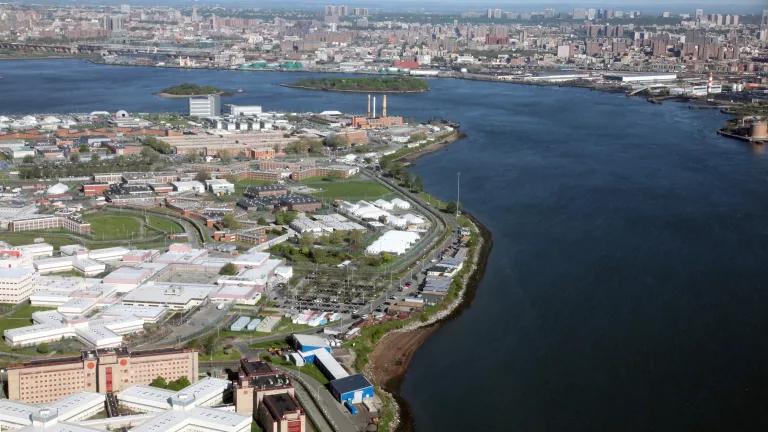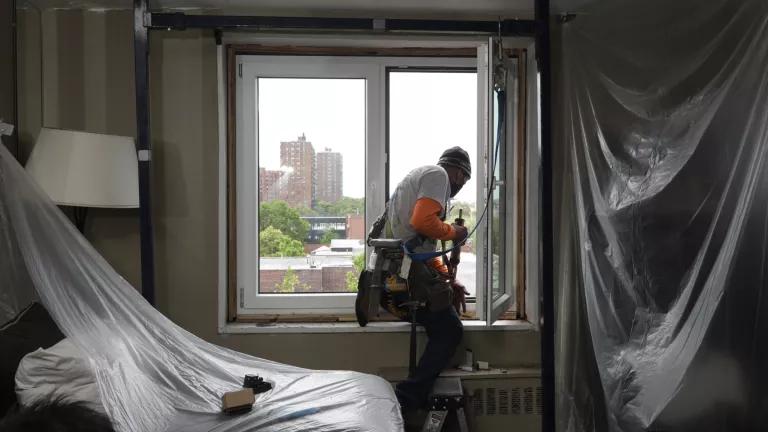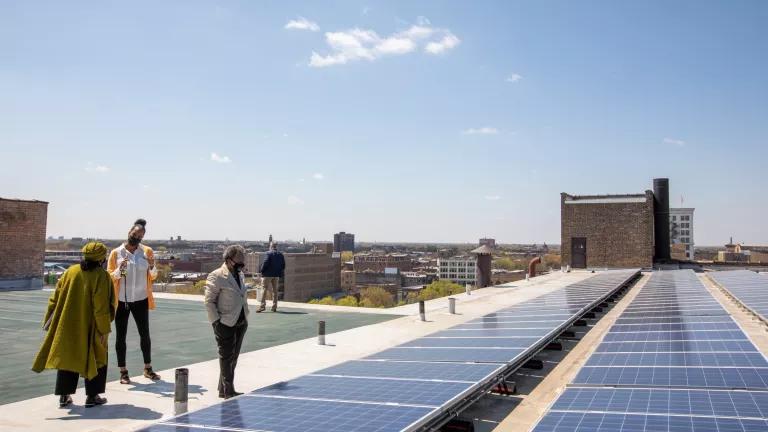Major Victory in Coalition Push for Renewable Rikers Island
The New York City Council passed two bills that, when signed into law, will mark the beginning of the end for the notorious Rikers Island jail complex and transform the island into a model of green infrastructure and jobs.

Aerial view of the Rikers Island jail complex, located in the East River between Queens and the Bronx in New York City
Today the New York City Council passed two bills that, when signed into law, will mark the beginning of the end for the notorious Rikers Island jail complex.
The first bill, Intro 1592-A, requires that no later than August 31, 2027, “all portions of Rikers Island shall be fully transferred” to the Department of Citywide Administrative Services (DCAS) and “shall no longer be used by the Department of Correction for the housing of incarcerated persons.”
The second bill, Intro 1593-A, directs the Mayor’s Office of Long-Term Planning and Sustainability to conduct a feasibility study for constructing renewable energy sources and battery storage facilities on Rikers Island. The legislation was spearheaded by Queens Councilmember Costa Constantinides, with support from Speaker Corey Johnson.
This victory in the campaign to close the Rikers Island jails and transform the island into a model of green infrastructure and jobs comes after years of organizing by frontline environmental justice organizations and community members directly impacted by incarceration there.
The Rikers Island jail complex is the second largest in the United States, and it houses almost all of the more than 5,000 people held in custody of the City Department of Correction. A disproportionate 87 percent of people jailed are Black or Latino, despite making up a little more than half of New York City’s overall population. And as of late last year, in the midst of the COVID-19 pandemic, approximately 72 percent of people were being held on pretrial detention, often because they are unable to afford money bail. The Rikers Island jails have long been plagued by inhumane conditions, inclusive of odors, heat, flooding, violence, and human rights abuses, as reported by people in custody, New York State commissions, and independent commissions alike.
Essential to the Renewable Rikers vision is that the island’s overhaul must directly benefit the same low-income communities of color that the jail complex and New York City’s policies of mass incarceration have most harmed. Transforming Rikers’ 413 acres into a model for environmental sustainability offers an opportunity to do just that. This reimagining of the island could make it possible to decommission polluting peaker power plants and inefficient wastewater treatment facilities burdening environmental justice communities, while creating new green jobs on the island. In alignment with the principles of a just transition, the properties that would be vacated by closing these aging facilities in other parts of the city should open the possibility for creative reuse of the land as envisioned by those directly impacted communities.
To further ensure robust community representation in decision-making about the future of Rikers Island, Intro 1592-A establishes a 15-member advisory committee whose membership will include at least four people who have been impacted directly by incarceration on Rikers Island and at least three people who hold expertise in environmental justice or sustainability. DCAS must work with this committee to plan and coordinate the future uses of Rikers Island “for sustainability and resiliency purposes,” which include “renewable energy generation and storage, wastewater treatment, and organic waste processing.”
Importantly, the legislation does more than just establish an August 2027 deadline for the end of incarceration on Rikers Island. It directs the Mayor to assess the current use of Rikers Island, beginning July 2021 and every six months thereafter, and transfer to DCAS those portions of the island not in active use for housing of incarcerated persons or providing direct services to them. This mandate creates the opportunity to begin making progress on closing unused portions of the jail complex, transferring jurisdiction away from the Department of Correction, and building New York City’s green future on the island as early as later this year.
NRDC stands with our core coalition partners Freedom Agenda, the New York City Environmental Justice Alliance, New York Lawyers for the Public Interest, the Independent Commission on New York City Criminal Justice and Incarceration Reform, and many others to endorse and continue the campaign for a Renewable Rikers Island.





